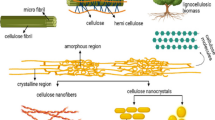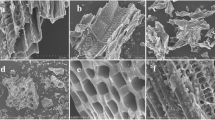Abstract
Utilizing agricultural wastes into value-added products of a low-cost adsorbent has become of interest in recent years. In this study, sago-silica composite with a ratio of 80:20 (w/w%) was prepared via chemical grafting of abundantly available sago waste and rice husk. The physicochemical properties of the composites were characterized, and their efficiencies as adsorbents on the removal of chromium (Cr), lead (Pb), and copper (Cu) in aqueous media were studied as a function of pH, adsorbent dosage, initial concentration, and contact time. Results showed that the sago-silica composite has a more extensive surface area of 227.7 m2/g compared to SAC (167.3 m2/g). The adsorption of Cr and Cu gave excellent monolayer and heterolayer adsorption on sago-silica composite represented by Langmuir and Freundlich’s isotherm based on coefficient regression, R2 > 0.9. Pseudo-second-order kinetics model showed best fitted with excellent adsorption capacity qe of Cr, Pb, and Cu adsorption on sago-silica composites, which demonstrated the occurrence of chemisorption process between the composite and metal ions. The composite from carbon–silica is one of the cost-effective natural sorbents which demonstrate excellent removal of heavy metal from the aqueous environment.






Similar content being viewed by others
Data Availability
The data, generated from the experiment, supporting the findings of this study are available within the article and its supplementary information files.
References
Ademiluyi, F. T., & Nze, J. C. (2016). Multiple adsorption of heavy metal ions in aqueous solution using activated carbon from Nigerian bamboo. International Journal of Research in Engineering and Technology, 5(1), 164–169.
Alam, M. M., Hossain, M. A., Hossain, M. D., Johir, M. A. H., Hossen, J., Rahman, M. S., Zhou, J. L., Hasan, A., Karmakar, A. K., & Ahmed, M. B. (2020). The potentiality of rice husk-derived activated carbon: From synthesis to application. Processes, 8(2), 203. https://doi.org/10.3390/pr8020203
Cuske, M., Gersztyn, L., & Karczewska, A. (2013). The influence of pH on solubility of copper in soils contaminated by copper industry in Legnica. Civil and Environmental Engineering Reports, 11, 31–39.
Daochalermwong, A., Chanka, N., Songsrirote, K., Dittanet, P., Niamnuy, C., & Seubsai, A. (2020). Removal of heavy metal ions using modified celluloses prepared from pineapple leaf fiber. ACS Omega, 5(10), 5285–5296. https://doi.org/10.1021/acsomega.9b04326
Gao, J., Kong, D., Wang, Y., Wu, J., Sun, S., & Xu, P. (2013). Production of mesoporous activated carbon from tea fruit peel residues and its evaluation of methylene blue removal from aqueous solutions. BioResources, 8(2), 2145–2160.
Heidarinejad, Z., Dehghani, M., Heidari, M., Javedan, G., Ali, I., & Sillanpää, M. (2020). Methods for preparation and activation of activated carbon: A review. Environmental Chemistry Letters, 18, 393–415. https://doi.org/10.1007/s10311-019-00955-0
Hegde, G., Abdul Manaf, S. A., Kumar, A., Ali, G. A., Chong, K. F., Ngaini, Z., & Sharma, K. V. (2015). Biowaste sago bark based catalyst free carbon nanospheres: waste to wealth approach. ACS Sustainable Chemistry & Engineering, 3(9), 2247–2253. https://doi.org/10.1021/acssuschemeng.5b00517
Ho, Y. S., & McKay, G. (1999). Pseudo-second order model for sorption processes. Process Biochemistry, 34(5), 451–465. https://doi.org/10.1016/S0032-9592(98)00112-5
Imran-Shaukat, M., Wahi, R., Rosli, N. R., Aziz, S. M., & Ngaini, Z. (2021). Chemically modified palm kernel shell biochar for the removal of heavy metals from aqueous solution. IOP Conference Series: Earth and Environmental Science, 765, 012019. https://doi.org/10.1088/1755-1315/765/1/012019
Karnib, M., Kabbani, A., Holail, H., & Olama, Z. (2014). Heavy metals removal using activated carbon, silica and silica activated carbon composite. Energy Procedia, 50, 113–120. https://doi.org/10.1016/j.egypro.2014.06.014
Kate, G. U., & Chaurasia, A. S. (2018). Gasification of rice husk in two-stage gasifier to produce syngas, silica and activated carbon. Energy Sources, Part a: Recovery, Utilization, and Environmental Effects, 40(4), 466–471. https://doi.org/10.1080/15567036.2017.1423418
Ludueña, L. N., Fasce, D. P., Alvarez, V. A., & Stefani, P. M. (2011). Nanocellulose from rice husk following alkaline treatment to remove silica. Bio Resources, 6(2), 1440–1453
Makshut, N. A., Ngaini, Z., Wahi, W., Hussain, H., Mahmut, N. I., & Bahrin, N. Q. (2020). Nano-sized absorbent from pyrolysed sago activated sludge for removal of Pb(II) from aqueous solution. Pertanika Journal of Science and Technology, 28, 893–916.
Malik, D., Jain, C., & Yadav, A. (2016). Removal of heavy metals from emerging cellulosic low-cost adsorbents: A review. Applied Water Science, 7, 2113–2136. https://doi.org/10.1007/s13201-016-0401-8
Manaf, S. A. A., Roy, P., Sharma, K. V., Ngaini, Z., Malgras, V., Aldalbahi, A., Alshehri, S. M., Yamauchi, Y., & Hegde, G. (2015). Catalyst-free synthesis of carbon nanospheres for potential biomedical applications: Waste to wealth approach. RSC Advances, 5(31), 24528–24533. https://doi.org/10.1039/C4RA14693J
Ngaini, Z., Noh, F., & Wahi, R. (2018). Facile sorbent from esterified cellulosic sago waste for engine oil removal in marine environment. International Journal of Environmental Science and Technology, 15(2), 341–348. https://doi.org/10.1007/s13762-017-1389-9
Ngaini, Z., Wahi, R., Hussain, H., Bahrin, N. Q., & Hasana, N. H. (2021a). Heavy metal adsorbent of carbon from sago liquid biowaste for sustainable technology. In M. A. A. Zaini, M. Jusoh, & N. Othman (Eds.), Proceedings of the 3rd International Conference on Separation Technology Lecture Notes in Mechanical Engineering (pp. 205–216). Springer. https://doi.org/10.1007/978-981-16-0742-4_14
Ngaini, Z., Jamil, N., Wahi, R., Shahrom, F. D., Ahmad, Z. A., & Farooq, S. (2021b). Convenient conversion of palm fatty acid distillate to biodiesel via rice husk ash catalyst. BioEnergy Research, 1-11https://doi.org/10.1007/s12155-021-10331-y
Onundi, Y. B., Mamun, A. A., Al Khatib, M. F., & Ahmed, Y. M. (2010). Adsorption of copper, nickel and lead ions from synthetic semiconductor industrial wastewater by palm shell activated carbon. International Journal of Environmental Science & Technology, 7(4), 751–758.
Özsin, G., Kılıç, M., Apaydin-Varol, E., & Pütün, A. (2019). Chemically activated carbon production from agricultural waste of chickpea and its application for heavy metal adsorption: Equilibrium, kinetic, and thermodynamic studies. Applied Water Science, 9, 1–14. https://doi.org/10.1007/s13201-019-0942-8
Pathania, D., Sharma, S., & Singh, P. (2017). Removal of methylene blue by adsorption onto activated carbon developed from Ficus carida bast. Arabian Journal of Chemistry, 10, 1445–1451. https://doi.org/10.1016/j.arabjc.2013.04.021
Quek, S. Y., Wase, D. A. J., & Forster, C. F. (1998). The use of sago waste for the sorption of lead and copper. Water SA, 24(3), 251–256.
Rajan, Y., Ngaini, Z., & Wahi, R. (2019). Novel adsorbent from sago-grafted silica for removal of methylene blue. International Journal of Environmental Science and Technology, 16(8), 4531–4542. https://doi.org/10.1007/s13762-018-2043-x
Supriya, S., Sriram, G., Ngaini, Z., Kavitha, C., Kurkuri, M., De Padova, I. P., & Hegde, G. (2020). The role of temperature on physical–chemical properties of green synthesized porous carbon nanoparticles. Waste and Biomass Valorization, 11(7), 3821–3831. https://doi.org/10.1007/s12649-019-00675-0
Valle-Vigón, P., Sevilla, M., & Fuertes, A. B. (2012). Sulfonated mesoporous silica–carbon composites and their use as solid acid catalysts. Applied Surface Science, 261, 574–583. https://doi.org/10.1016/j.apsusc.2012.08.059
Wahi, R., Ngaini, Z., & Jok, V. U. (2009). Removal of mercury, lead and copper from aqueous solution by activated carbon of palm oil empty fruit bunch. World Applied Sciences Journal, 5, 84–91.
Wahi, R., Chuah, A. L., Nourouzi, M. M., Ngaini, Z., & Choong-Shean-Yaw, T. (2017). Utilization of esterified sago bark fibre waste for removal of oil from palm oil mill effluent. International Journal of Chemical Engineering, 5(1), 170–177. https://doi.org/10.1016/j.jece.2016.11.038
Zhao, M., Xu, Y., Zhang, C., Rong, H., & Zeng, G. (2016). New trends in removing heavy metals from wastewater. Applied Microbiology and Biotechnology, 100, 6509–6518. https://doi.org/10.1007/s00253-016-7646-x
Zohre, S., Ataallah, S. G., & Mehdi, A. (2010). Experimental study of methylene blue adsorption from aqueous solutions onto carbon nanotubes. International Journal of Water Resources and Environmental Engineering, 2(2), 016–028. https://doi.org/10.5897/IJWREE.900002
Funding
This study received funding from the University of Malaysia Sarawak from Tun Openg Sago Research Chair (F07/TOC/1742/2018).
Author information
Authors and Affiliations
Contributions
YR prepared the adsorbent and demonstrated the removal of Cr, Pb, and Cu in aqueous media. ZN and RW analyzed and interpreted the data. ZN and RW equally contributed in writing the manuscript. All authors read and approved the final manuscript.
Corresponding authors
Ethics declarations
Consent for Publication
Not applicable.
Competing Interests
The authors declare no competing interests.
Additional information
Publisher's Note
Springer Nature remains neutral with regard to jurisdictional claims in published maps and institutional affiliations.
Supplementary Information
Below is the link to the electronic supplementary material.
Rights and permissions
About this article
Cite this article
Ngaini, Z., Rajan, Y. & Wahi, R. Carbon–Silica Composites from Sago Waste for the Removal of Chromium, Lead, and Copper from Aqueous Solution: Kinetic and Equilibrium Isotherm Studies. Water Air Soil Pollut 232, 441 (2021). https://doi.org/10.1007/s11270-021-05393-9
Received:
Accepted:
Published:
DOI: https://doi.org/10.1007/s11270-021-05393-9




